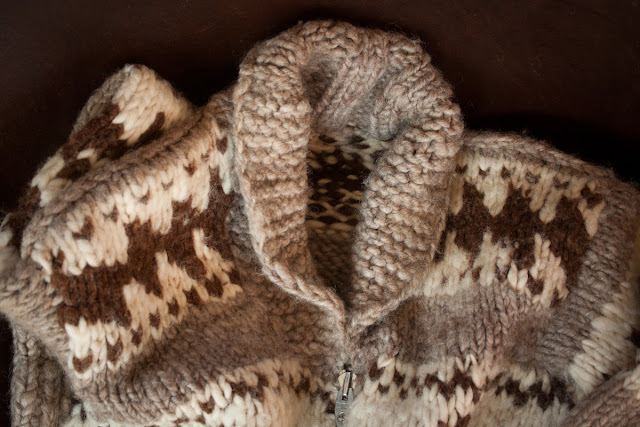Vintage Hunting and Zipper Dating - A Thunderbird Cowichan Sweater
What we call a "Cowichan sweater" was developed in Vancouver, BC by the Cowichan native people following the introduction of sheep's wool by Europeans in the 1850s. Over time, they incorporated the Fair Isle technique of woven pattern making to incorporate traditional native symbols and designs into their work, eventually becoming the iconic sweaters we know today.
 |
| Authentic Cowichan |
I asked David if he had any idea who made the one I bought. "Nope."
Well, crap.
Well, crap.
 Vintage shopping can be intimidating to begin with, and developing a working knowledge of how to evaluate quality and style in clothing from half a century ago or more is a task that takes time and a specific type of experience that you don't just pick up unless you go out of your way to do it. Naturally one of the first things most people take a peek at are the tags before throwing on that shirt or jacket in the mirror. Well, there are no tags or markings on the inside of this piece - no maker, no fabric or care tags, no nothing. What I could tell from initial inspection was that the yarn feels like 100% heavy gauge wool and it appears to be in great shape; no stains or holes, a remarkably small amount of pilling, and it doesn't stink like the dreaded vintage five decades-of armpit-swamp-ass. That's a good start.
Vintage shopping can be intimidating to begin with, and developing a working knowledge of how to evaluate quality and style in clothing from half a century ago or more is a task that takes time and a specific type of experience that you don't just pick up unless you go out of your way to do it. Naturally one of the first things most people take a peek at are the tags before throwing on that shirt or jacket in the mirror. Well, there are no tags or markings on the inside of this piece - no maker, no fabric or care tags, no nothing. What I could tell from initial inspection was that the yarn feels like 100% heavy gauge wool and it appears to be in great shape; no stains or holes, a remarkably small amount of pilling, and it doesn't stink like the dreaded vintage five decades-of armpit-swamp-ass. That's a good start. I took my new old sweater home and started digging deeper to see if I could find any more information about its origins or approximate date of manufacture. Doing an extensive image search didn't help much, aside from the fact that the pattern doesn't exactly match any new or vintage examples I could find online. That tilts the tables ever so slightly in the handmade/one-of-a-kind direction, although it's not uncommon at all to not find an identical item in vintage clothing laying around the net. Perhaps the most helpful feature on the sweater aside from its material and traditional style is its zipper. It's not a standard YKK - it's a big ellipse pull with "Lightning" printed in block letters and "LF" at the base.
It turns out "LF" stands for Lightning Fastener Company, a zipper company in Ontario and one of the early manufacturers of zippers in the 20th century while they were still in the process of becoming accepted by the general public on clothing. The plant continued to function making zippers until its closure in 1981. So we can presume a couple of things: that this sweater is either Canadian made, or much less likely that some deadstock zippers were used to make a more recent sweater as is done with some vintage-inspired clothing companies (leather jackets like Himmel Bros, for example). Assuming the zipper was originally sewn on the sweater when it was made and that the zipper wasn't sitting around for years prior to its use, that also dates the sweater prior to the early 1980's at latest.
 |
| Vintage Lightning zippers - right shape, but different lettering on the pull tab |
 |
| Lightning Zipper on a vintage leather jacket |
 |
| An exact match on the Lightning zipper |
As you can see, this isn't an exact science, but an educated guess would characterize this Cowichan sweater as Canadian made, circa 1950-1960s, and all from a zipper. Pretty cool.
I already mentioned this in passing, but if you're in the Philadelphia area I'd highly recommend stopping by Briar Vintage's second floor warehouse studio space on 4324 Tackawanna St on Saturdays from 12-6 PM open to the public, or making an appointment to tour the warehouse privately on your own. Briar also has a storefront open on 618 S. 6th St that's shared with sister store Sazz Vintage, but in the warehouse studio space you get pure, unadulterated vintage menswear at a much higher volume, and David may cut you a great deal on items that haven't made it to dry cleaning or he hasn't been able to photograph and post for sale.
















I have a 50 year old Hudson Bay wool jacket with a thunder zipper👍
ReplyDeleteDuh! Lightning brand not thunder😜
DeleteI got a Lightning zipper on a 1940s British slip! https://nylonnostalgia.com/f/1940s-fashion-celanese-fabric-vintage-full-slip
ReplyDelete